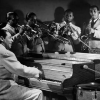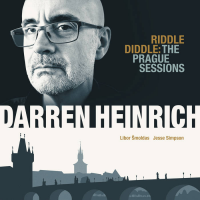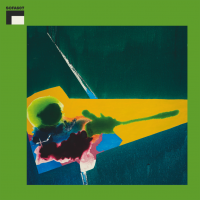Home » Jazz Articles » Album Review » Duke Ellington And His Orchestra: The Treasury Shows, Vol. 24
Duke Ellington And His Orchestra: The Treasury Shows, Vol. 24
In uncertain times, Duke took good care of business. On this, latest in The Treasury Shows series of reissues by Storyville, in a broadcast from July 24, 1953, Ellington makes several "twists and turns." He shamelessly plugs, over and over again, the venue for the broadcast, Chicago's Blue Note club—"Chicago's beautiful air-conditioned Blue Note club," Ellington purrs, as only he can, "Cool in triplicate."
With Johnny Hodges still doing his own thing, it might not have been the greatest orchestra Duke ever fronted but there were still plenty of star names: Clark Terry, Cat Anderson, Ray Nance, Juan Tizol, Jimmy Hamilton, Paul Gonsalves and Harry Carney to name but seven. Terry features early on in a fine version of "Harlem Air Shaft."
Two regular band members, Russell Procope, who joined in 1946 and played New Orleans style clarinet, forms a seemingly unlikely collaboration with bopper Willie Cook (trumpet) to breathe new life into "Creole Love Call, written by Ellington in 1927.
Ray Nance (vocal) and Paul Gonsalves (saxophone) collaborate on a sometimes raggedy but fun version of "Just A-Settin' And A-Rockin.'"
Then, after a gruesome Latin number, "Moonlight Fiesta," Ellington unveils a truly great new composition, one that will stand the test of time. "Satin Doll," was written with Billy Strayhorn. The historic moment of its first broadcast is cut brutally short by NBC due to progamming.
The next session at the Blue Note contains a hint of changing times in "Blue Jean Beguine," a lesser known Ellington piece, featuring high note specialist Cat Anderson, which Duke says will soon be released as a single with Strayhorn's "Boo Dah" on the flipside.
Another version of "Satin Doll," this time dedicated by Duke to Louis Armstrong, "Old Satchmo himself," is also cut short by NBC.
The next session, at the Hurricane Club in New York in 1944, memorably includes Dizzy Gillespie in the Ellington line-up. At least that's what it says in the track listings. However, as neither Duke "live and in person" on NBC, nor Ulf W. Lundin, writing liner notes in the here and now, mention this alleged, illustrious guest, the historic occasion must be taken with a rather large pinch of salt.
The second CD sees the band playing first at the Bandbox in New York. "Come On Home" is credited on the track listings as being by Horace Silver while Lundin in his liner notes claims it as an Ellington original, which seems more plausible.
There's a version of "Satin Doll" that actually goes the distance before we're back in the air-conditioned glory of the Blue Note in Chicago where the tune suffers the indignity of being used as a fade-out for a pretty routine Ellington session.
Track Listing
CD1: Take The A Train; Harlem Air Shaft; Creole Love Call; C Jam Blues; Is It A Sin?; Just A-Settin’ And A-Rockin’; Moonlight Fiesta; The Hawk Talks; Satin Doll; Take The A Train; Blue Jean Beguine; Boo Dah; Cocktails For Two; Nothin’ Nothin’ Baby; Jump For Joy; Perdido; Blue Moon; Satin Doll; Take The A Train; Concerto For Cootie; Johnny Come Lately; My Heart Tells Me; Blue Skies; Things Ain’t What They Used To Be. CD2: Take The A Train; Caravan; I Let A Song Go Out Of My Heart; Bond Promo; The Hawk Talks; Come On Home; Flamingo; Bond Promo; Jump For Joy; Satin Doll; Take The A Train; Take The A Train; The Tattooed Bride; Bond Promo; Nothin’ Nothin’ Baby; Rock Skippin’ At The Blue Note; Just Squeeze Me; Ting-A-Ling; Satin Doll.
Personnel
Duke Ellington And His Orchestra
band / ensemble / orchestraClark Terry, Willie Cook, Cat Anderson, Ray Nance, Dizzy Gillespie (perhaps): trumpets; Quentin Jackson, Brit Woodman, Juan Tizol, Lawrence Brown: trombones; Jimmy Hamilton, Paul Gonsalves, Russell Procope, Elbert Williams, Johnny Hodges, Otto Hardwick, Harry Carney, Rick Henderson: reeds; Duke Ellington: piano; Fred Guy: guitar; Wendell Marshall, Wilsom Myers: bass; Sonny Greer, Butch Baillard: drums; Jimmy Grissom, Al Hibbler: vocals.
Album information
Title: The Treasury Shows, Vol. 24 | Year Released: 2017 | Record Label: Storyville Records
Tags
About Duke Ellington And His Orchestra
Instrument: Band / ensemble / orchestra
PREVIOUS / NEXT
Support All About Jazz
 All About Jazz has been a pillar of jazz since 1995, championing it as an art form and, more importantly, supporting the musicians who make it. Our enduring commitment has made "AAJ" one of the most culturally important websites of its kind, read by hundreds of thousands of fans, musicians and industry figures every month.
All About Jazz has been a pillar of jazz since 1995, championing it as an art form and, more importantly, supporting the musicians who make it. Our enduring commitment has made "AAJ" one of the most culturally important websites of its kind, read by hundreds of thousands of fans, musicians and industry figures every month.




















